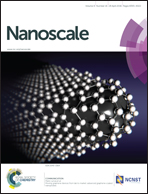Improving low-energy boron/nitrogen ion implantation in graphene by ion bombardment at oblique angles†
Abstract
Ion implantation is a widely adopted approach to structurally modify graphene and tune its electrical properties for a variety of applications. Further development of the approach requires a fundamental understanding of the mechanisms that govern the ion bombardment process as well as establishment of key relationships between the controlling parameters and the dominant physics. Here, using molecular dynamics simulations with adaptive bond order calculations, we demonstrate that boron and nitrogen ion bombardment at oblique angles (particularly at 70°) can improve both the productivity and quality of perfect substitution by over 25%. We accomplished this by systematically analyzing the effects of the incident angle and ion energy in determining the probabilities of six distinct types of physics that may occur in an ion bombardment event, including reflection, absorption, substitution, single vacancy, double vacancy, and transmission. By analyzing the atomic trajectories from 576 000 simulations, we identified three single vacancy creation mechanisms and four double vacancy creation mechanisms, and quantified their probability distributions in the angle-energy space. These findings further open the door for improved control of ion implantation towards a wide range of applications of graphene.


 Please wait while we load your content...
Please wait while we load your content...